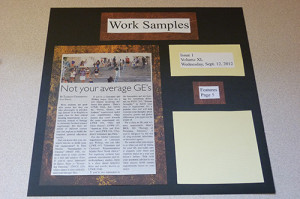By: Sarah Hughes
Having a work portfolio is sometimes industry standard. Having a physical, old-school version is a project I had to try.
Supplies:
Materials should be acid-free to prevent yellowing or decaying of the pages.
-
A Scrapbook (I recommend a plain design and neutral color, preferably 12” by 12” size. I got mine for $2.99 at Michaels Craft Store, but they usually range from that to $20. They usually come with clear page holders. You can buy them separately if you need more space).
-
Acid-free paper in a variety of designs and colors (I bought one black textured pack and one varied design pack).
-
Double-sided scrapbooking tape (Comes in a roll of sticky squares in most scrapbooking sections of stores like Michaels, JoAnns, Wal-Mart, etc.).
-
Ruler
-
Pencil
-
Scissors
-
Printed out headings or stickers for lettering so you can organize the portfolio and label what everything is
-
(Optional) Any stickers, brads, stencils or cut-out tools that you think would make your portfolio look more polished
-
(Optional) Headshot: pick a work-appropriate picture of your face. Headshots are important for certain fields
-
Short profile: type out a small summary of who you are and why you are good for the job you’re seeking. Include skills and interests relevant to your intended career or artistic passion. The profile section should be an extended version of the objective on your resume
-
Contacts: Print a sheet that lists all ways you would like a prospective employer to contact YOU. This could include your website if you have one.
-
Links to your work: Similar to contacts, but needs it’s own heading and page. List links to your previous work.
-
(Optional) A cover letter: print out a general version of a cover letter.
-
Resume: print a polished copy of your resume out.
-
Work Samples: collect a variety of work samples. The more you have the better. If you have too many to choose from, pick your best and a variety that highlights your different work and skills. If you are using newspaper articles, it’s a good idea to make copies on acid-free paper, because newsprint has a habit of yellowing and curling. I have these, but wanted a portfolio that had the actual newsprint, because I kind of like the feel of old newspapers.
-
Any letters of recommendation or awards you have
-
A list of appropriate references. The list should be varied: people you’ve worked with, character references, people you’ve volunteered for, teachers. Above all, be sure they would say something nice about your work ethic and talents. Also, they should not be relatives or significant others…or worse, past significant others.
-
A digital copy of the portfolio: possibly the most important type of portfolio. It has basically the same thing as this physical one. It can be a CD of these items burned on it or a website. Most people will have digital copies of a portfolio and will not have the physical copy. I enjoy the physical copy in addition to the digital one for a few reasons. It’s a place to store my physical copies of my work, rather than having an entire stack of newspapers just cluttering up my desk. Also, friends and family enjoy looking at it. This may seem somewhat silly, except those same friends and family then know what I’m capable of, what I’m looking for career-wise and tell people word of mouth about my portfolio, which then leads to opportunities. Most importantly, I enjoy being able to control what a prospective employer is looking at of my work, during an interview.
-
(Optional) Extra physical (paper) copies of your cover letter, resume, references, contacts and links to your work
Process:
-
Decide what order you want the headshot, short profile, contacts, links to your work, resume and work samples.
-
Page by page, place whatever you are going to scrapbook in the clear sheet for now.
-
Starting with the first page, layout how you want the page to look. You can use a ruler and pencil to make sure everything is well placed. The first and last page I usually put a little more effort and design into so that it impresses immediately and concludes with a good impression. You can do this by using a particularly interesting piece of design paper.
-
Once you have a page laid out, turn over each piece and put a piece of memory tape on it. Then stick it together carefully. Do this page by page until you are done. Pages should flow into each other using similar design schemes and colors. These can slowly shift and merge using similar visual components. If you want to get more complicated, you can use a variety of scrapbooking pieces, like 3D stickers, brads, etc. Just remember the final product is going to be a work-related representation of you, so keep it tasteful and related to your talent. No “dirty girl” stickers.
-
Insert a digital copy of the portfolio (the CD version works well) into an envelope and then stick it to the inside cover of the book. Or you can have a physical copy for them. If you have a website, have the address ready on a piece of paper for them to keep, with any passwords they will need to view it, should you protect it by password (some photographers do this for private client pictures).
-
Have fun showing off your portfolio. In addition to taking it to interviews, consider sharing it with people who want to see it. Maybe they know someone who’s hiring.



